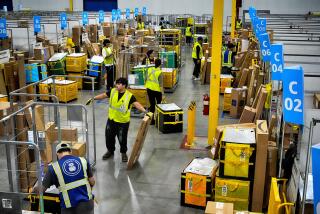Can Our Long Expansion Roll a 7?
- Share via
Not long ago, the economic expansion celebrated its sixth birthday. It was a significant event because the U.S. economy had never grown for six straight years without the help of a war. Indeed, if the expansion continues through the summer, it will become the second longest ever, surpassing the 80-month upswing that occurred during World War II.
In view of the fact that, over the past 130 years, a recession has struck once every 4.3 years, it would seem that the chances of this expansion lasting much longer are remote. Or are they? History may teach us some valuable lessons, but it doesn’t necessarily impose ironclad rules on us when it comes to the inevitability of recessions.
Keep in mind that the natural tendency of the U.S. economy is growth. The population is constantly expanding; education and technology are always boosting productivity, and people’s natural aspirations are to improve their living standards.
Keep in mind, also, the fact that recessions don’t come from outer space, from the weather, or from deep within the Earth. They are caused by policy makers, reacting to fears that this natural tendency toward growth at times can lead to overheating, thus to an upsurge in inflation.
When demand for goods and services outpaces supply, as it does from time to time, prices will rise. This may also coincide with other inflation-generating developments, such as bad weather affecting crops, strikes, wars and so on. The end result: a big run-up in
prices and a clampdown by the monetary and fiscal authorities to keep inflation from getting out of hand.
In the past this restraint has come in the form of tax hikes, spending cutbacks, a reduction in the money supply and sharply rising interest rates. Of course, the intent was to slow down demand, thus dampening price pressures. Sometimes demand slowed--but still expanded--and sometimes it actually contracted. When it declined, we experienced a recession.
The U.S. economy has managed to avoid a full-fledged recession for more than six years because of an unusual set of developments:
The last recession was so long and so deep that it left the economy with plenty of room to grow, in the form of unused capacity, vacant space and unemployed workers.
Early in the expansion, the dollar shot up in foreign exchange markets, dampening domestic price pressures, while at the same time forcing U.S. businesses to spend heavily on new machinery, computers, etc., to remain competitive.
Labor restrained its wage demands because of competition from abroad, as well as widespread domestic corporate restructurings. The surge in new machinery put in place boosted productivity, putting even more downward pressure on unit labor costs.
Oil prices began falling around the end of 1985, further dampening price pressures.
The stock market’s crash of October, 1987, ironically gave the expansion another lease on life by cooling things off, allowing the Federal Reserve to push interest rates lower, at least temporarily.
While capacity may be snug in some industries, consumer spending has tapered off at the same time, reflecting satisfied demands, a need to rebuild savings and to service relatively high debt loads.
After falling for three years, the dollar stabilized in 1988, taking pressure off inflation from the standpoint of rising prices of imports as well as from too strong exports.
Having said all this, can we now expect to set more records for this expansion? Or have we just about run out of luck when it comes to inflation-retarding developments?
At the moment, things seem to be getting out of balance. We are still consuming more than we are producing, as evidenced by the deficits in both our domestic budget and in our trade balance with other countries. This is being only partly offset by the reluctance of the Fed to provide enough money to satisfy all these demands: Short-term interest rates rose nearly three percentage points in 1988 alone while long-term yields climbed about three-quarters of a point.
As a result, the economy is apparently growing fast enough to generate a rise in the rate of inflation. In the past 12 months, the consumer price index has risen almost 5%, compared to 4.4% in 1987.
To keep the economy from getting further out of balance, we must bring consumption and production into closer alignment. This will permit the Fed to relax its grip on the supply of money and credit, enabling interest rates to fall. Lower interest rates are the key to maintaining economic growth.
It is to be hoped that the new President and the new Congress will be able to come up with a plan to reduce Washington’s budget deficit. For when you talk about bringing consumption and production closer together, the buck starts here.
More to Read
Inside the business of entertainment
The Wide Shot brings you news, analysis and insights on everything from streaming wars to production — and what it all means for the future.
You may occasionally receive promotional content from the Los Angeles Times.










